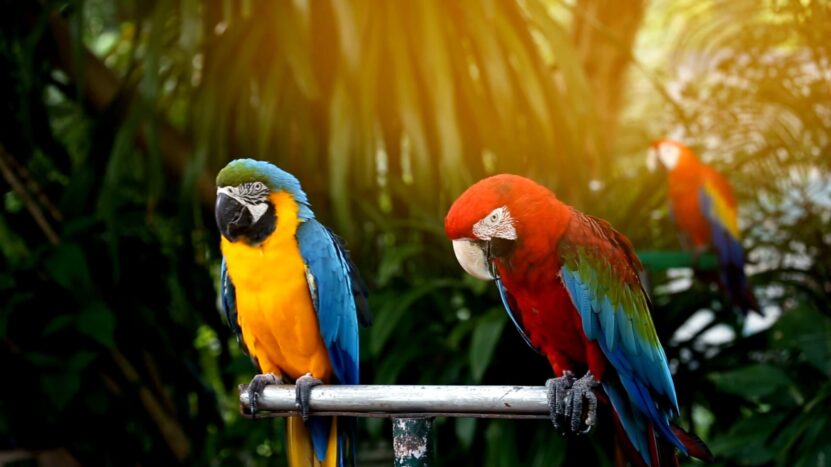Have you ever been captivated by the vibrant colors of Guacamayas, also known as Macaws? These long-tailed, often colorful parrots are not just a sight to behold but play a significant role in our ecosystem.
Originating from the New World, they’ve become popular in aviculture and as companion parrots. However, there’s a pressing concern about their conservation status in the wild. Let’s embark on this journey to understand more about these magnificent birds.
Fun Fact: A macaw’s facial feather pattern is as unique as a human fingerprint!
The Diversity of Guacamayas

Six genera are classified as macaws: Ara, Anodorhynchus, Cyanopsitta, Primolius, Orthopsittaca, and Diopsittaca.
These birds are native to regions spanning Central America, North America (specifically Mexico), South America, and previously, the Caribbean. Depending on the species, they can be found in forests, woodlands, or savannah-like habitats.
Within these groups, the Great Green Macaw and Yellow-Napped Parrot are both critically endangered, while the Scarlet Macaw is on a steep decline in the wild.
Pro Tip: If you’re an avid bird watcher, you might want to note that the largest macaws are the hyacinth, Buffon’s (great green), and green-winged macaws. On the other hand, the smallest member of the family, the red-shouldered macaw, is no larger than some parakeets!
Factors Threatening Guacamayas
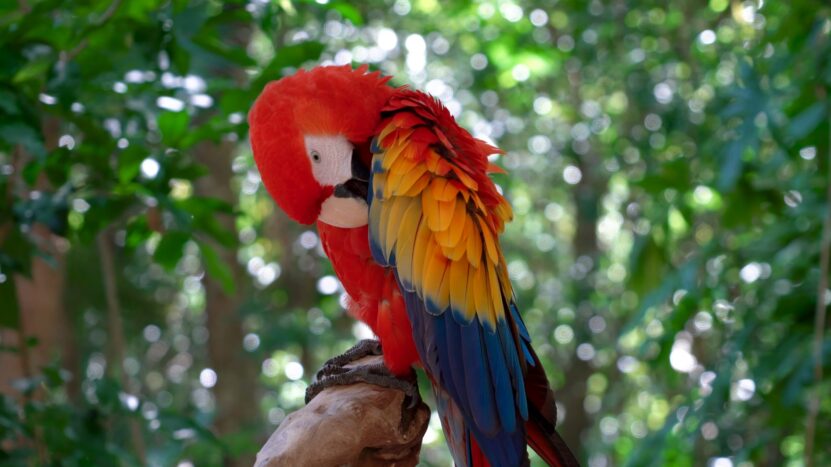
Unfortunately, the beauty and allure of the Macaws have also made them vulnerable.
- Their habitats are being destroyed at an alarming rate due to deforestation.
- Illegal trapping for the bird trade further exacerbates their declining numbers.
- Climate change, a global concern, is also affecting their natural habitats.
- Additionally, they face threats from predators, diseases, and disturbances caused by human activities.
Did you know? The Spix’s macaw is now probably extinct in the wild, and the glaucous macaw has had only two reliable sightings in the 20th century. The rapid rate of deforestation and illegal trapping are the primary culprits behind their dwindling numbers.
Conservation Efforts
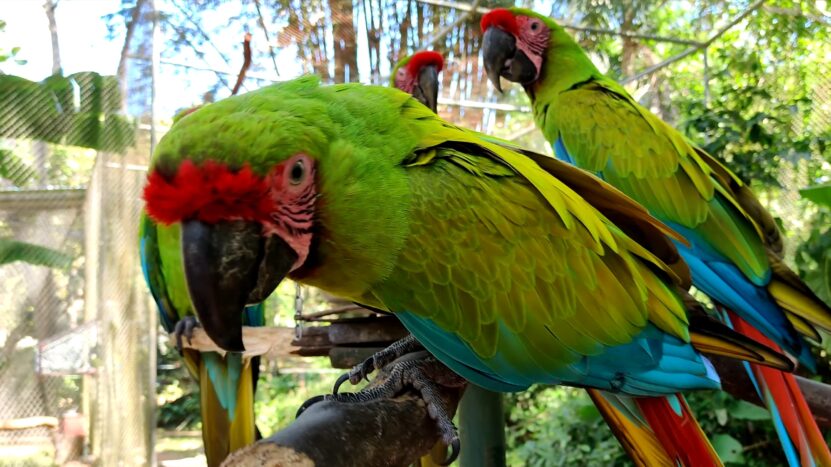
The plight of the Guacamayas has not gone unnoticed. Organizations and individuals worldwide are rallying to ensure these birds continue to grace our skies. Here’s a glimpse into the commendable work being done:
Thriving Birds
The Macaw Recovery Network, spearheaded by Dr. Sam Williams, is at the forefront of ensuring the survival of these birds. Recognizing the challenges faced by Macaws in the wild, such as their slow life-history and threats, the Network supports threatened species like the Great Green and Scarlet Macaws, and the Yellow-naped amazon parrot.
Teams in the field monitor wild nests, ensuring chick survival. Their Breeding Center houses over 80 rescued Scarlet and Great Green Macaws. These birds are provided with nutritious diets, enrichment toys, training, and health checks before being released into the wild using a soft release technique.
Intact Habitat
Between 1940 and 1990, a staggering 54% of Costa Rica’s forest cover vanished, primarily due to the rise of monocultures like pineapple and banana plantations. The Macaw Recovery Network’s habitat protection and restoration program is combating this. They focus on integrating communities into long-term solutions.
Their native tree nursery houses hundreds of seeds and saplings. As these saplings grow, the Network collaborates with private landowners to protect essential trees like the Mountain Almond, which the Great Green Macaw heavily relies on.
Pro Tip: If you’re planning a trip to Costa Rica, consider visiting the Punta Islita Wild Macaw Reserve. Not only will you witness these magnificent birds in their natural habitat, but you’ll also be directly supporting Parrot Conservation.
Unified Communities
Conservation isn’t just about the animals; it’s about the people too. The Macaw Recovery Network understands this and works closely with local communities to ensure the long-term survival of the Macaws.
Their Community Outreach program empowers locals to become rangers, educates children and adults, and involves local landowners in reforestation efforts. They even have a native tree nursery run by a team of Community Female Rangers in Boca Tapada.
Case Studies
The Scarlet Macaw’s Comeback
The Scarlet Macaw, known as guacamaya roja or Ara macao, is one of Central America’s most cherished species. Thanks to decades-long conservation efforts, this bird has made a significant comeback, especially in areas like Honduras. Their recovery is a testament to the power of dedicated conservation work.
Military Macaw Conservation in Bahia de Banderas
In the Banderas Bay region, there’s a dedicated effort to gather biological data necessary for the management and conservation of Military Macaw nests. This data-driven approach ensures that the conservation efforts are effective and targeted.
The Role of Education and Awareness
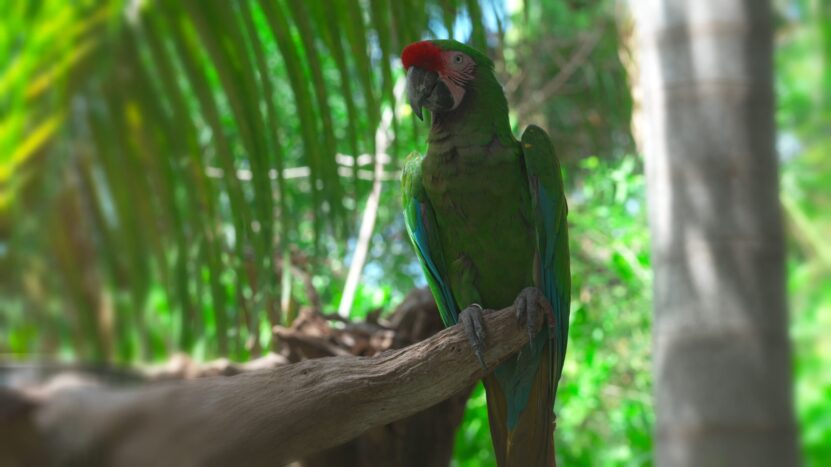
Education is the cornerstone of any successful conservation effort. The Macaw Recovery Network places a strong emphasis on educating the public:
- Promoting Awareness: By working with local communities, the Network ensures that the importance of Macaws is understood at a grassroots level. This involves changing attitudes and behaviors towards wildlife, which are key factors in making conservation successful.
- Educational Programs: The Network runs programs that inspire both kids and adults. By instilling a love for nature and an understanding of the importance of Macaws, they’re building a generation of conservationists.
- Responsible Tourism: Tourists play a significant role in conservation. By promoting responsible tourism practices, the Network ensures that visitors have a minimal impact on the environment and the Macaws.
Did you know? The Great Green and the Scarlet Macaws are two of the most recognizable parrot species in the world. However, due to rapid declines in their numbers, they desperately need our help.
Future Outlook
The future of Guacamayas is intricately linked to our actions today. Recent studies, particularly by the Macaw Society at Texas A&M University College of Veterinary Medicine & Biomedical Sciences, have shed light on the movements and habits of these majestic birds. Here’s what the future might hold:
Understanding Movements
Historically, tracking the migratory movements of large parrots and macaws was challenging due to the vast distances they travel. However, with the advent of satellite tracking, we now have a clearer picture.
For instance, both the scarlet macaws and blue-and-yellow macaws have vast home ranges, often spanning thousands of hectares. They can travel between 12 to 25 miles a day and move up to 99 miles during periods of low food availability, likely in search of dense patches of food trees.
Pro Tip: Satellite telemetry, which uses orbiting satellites to detect signals emitted from transmitters attached to animals, has revolutionized our understanding of animal movements.
Conservation Status
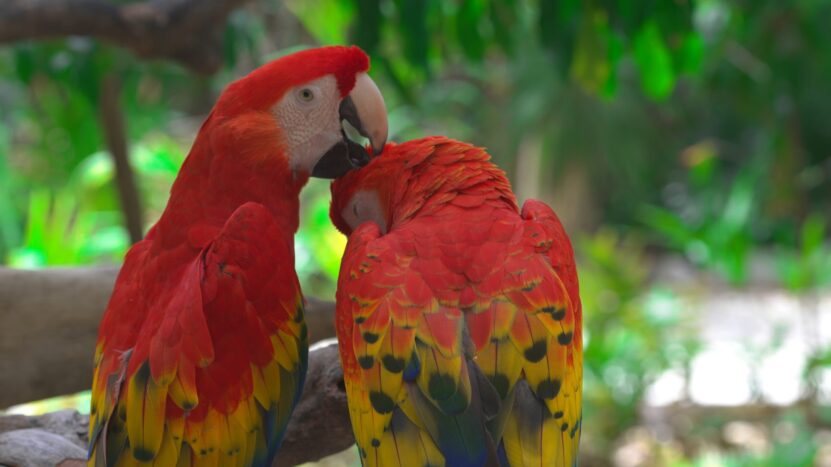
While the scarlet macaw is currently listed as “least concern” by the International Union for Conservation of Nature, it’s essential to note that their numbers are declining in many parts of Central and South America. They share their habitats with numerous endangered species, emphasizing the interconnectedness of our ecosystems.
Influencing Ecosystems
Macaws play a pivotal role in the ecosystems they inhabit. Their presence or absence can have ripple effects on other species and the environment at large. As such, their conservation is not just about saving one species but about preserving a balanced and thriving ecosystem.
Did you know? The Macaw Society’s long-term research in Peru’s Tambopata National Reserve has been instrumental in understanding the ecology and conservation needs of macaws and other parrots.
FAQ
Why is the Scarlet Macaw listed as “least concern” despite declining numbers in some regions?
While the Scarlet Macaw has declining populations in certain areas, its overall global population is still relatively stable, leading to its “least concern” status.
How do Guacamayas contribute to their ecosystems?
Guacamayas play a role in seed dispersal, helping in forest regeneration. Their presence also indicates a healthy ecosystem due to their role in the food chain.
How can individuals contribute to the conservation of Guacamayas?
Individuals can support conservation organizations, adopt sustainable practices, raise awareness, and avoid purchasing wild-caught birds as pets.
Wrapping Up
The vibrant colors and mesmerizing beauty of the Guacamayas are a testament to nature’s wonders. However, their declining numbers serve as a stark reminder of the fragility of our ecosystems. The importance of continued conservation efforts cannot be overstated.
It’s not just about preserving a species but about ensuring the balance and health of our planet. Each one of us has a role to play.
Whether it’s supporting conservation initiatives, educating ourselves and others, or making sustainable choices, every action counts. Let’s come together to ensure that the skies continue to be graced by the majestic flight of the Guacamayas.

